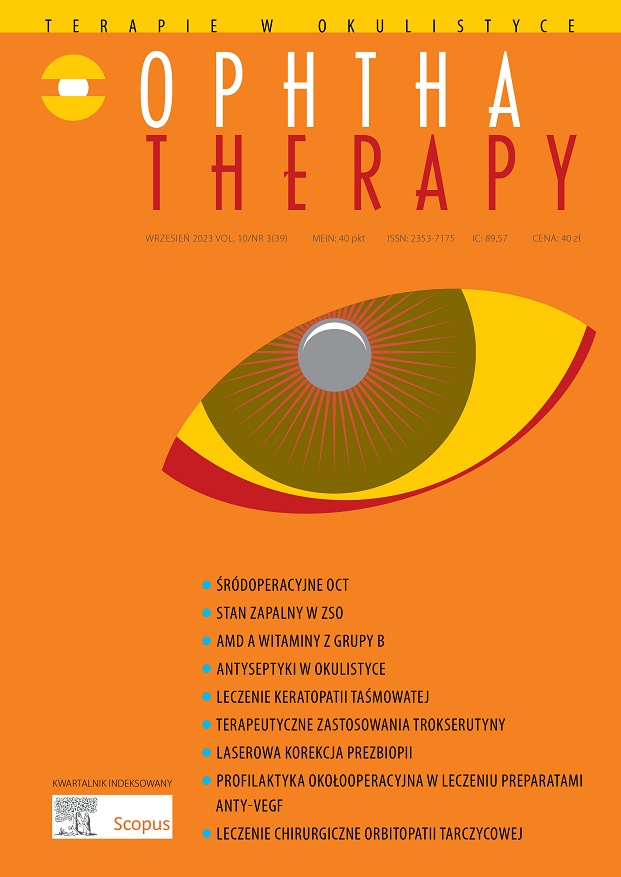Will antiseptics become the standard in ophthalmology in the future? Review article
Main Article Content
Abstract
Antiseptics are a group of substances widely used in ophthalmology for many years. They are well established, especially in the prevention of perioperative infections. For decontamination in ophthalmology, a 5% povidone-iodine solution is used as a standard for the conjunctival sac. It is considered the most effective preoperative antisepsis. In patients with an allergy to iodine, a solution of 0.05% chlorhexidine is recommended. There are also attempts to use other antiseptics and antibiotics for perioperative prophylaxis. Recently, there has also been interest in potential use antiseptics for the treatment of conjunctivitis.
Downloads
Article Details

This work is licensed under a Creative Commons Attribution-NonCommercial-NoDerivatives 4.0 International License.
Copyright: © Medical Education sp. z o.o. License allowing third parties to copy and redistribute the material in any medium or format and to remix, transform, and build upon the material, provided the original work is properly cited and states its license.
Address reprint requests to: Medical Education, Marcin Kuźma (marcin.kuzma@mededu.pl)
References
2. Parikh SR, Parikh RS. Chemical disinfectants in ophthalmic practice. Indian J Ophthalmol. 2021; 69(3): 510-6.
3. Biuletyn Informacji Publicznej. Wykaz produktów biobójczych. Online.
4. Różański H. Środki antyseptyczne i odkażające stosowane w medycynie. Środki antyseptyczne stosowane w leczeniu i w profilaktyce chorób skórnych oraz błon śluzowych. Środki antyseptyczne dawne i współczesne. Dzieje antyseptyki. Przegląd literatury i badania własne. Online.
5. Alharbi SA, Wainwright M, Alahmadi TA et al. What if Fleming had not discovered penicillin? Saudi J Biol Sci. 2014; 21(4): 289-93.
6. Azari AA, Barney NP. Conjunctivitis: a systematic review of diagnosis and treatment. JAMA. 2013; 310(16): 1721-9.
7. Grzybowski A, Kanclerz P, Myers WG. The use of povidone-iodine in ophthalmology. Curr Opin Ophthalmol. 2018; 29(1): 19-32.
8. Grzybowski A, Turczynowska M. More Antisepsis, Less Antibiotics Whenever Possible. Asia Pac J Ophthalmol (Phila). 2018; 7(2): 72-5.
9. Liu JY, Chu HS, Wei YH et al. Review, analysis, and education of antiseptic related ocular injury in the surgical settings. Ocul Surf. 2021; 22: 60-71.
10. Kanclerz P, Myers WG. Potential substitutes for povidone-iodine in ocular surgery. Eye. 2021; 35(10): 2657-9.
11. Zaharia AC, Dumitrescu OM, Rogoz RE et al. Preoperative antisepsis in ophthalmic surgery (a review). Rom J Ophthalmol. 2021; 65(2): 120-4.
12. Smit D. Anti-infective ophthalmic preparations in general practice. S Afr Fam Pract. 2012; 54(4): 302-7.
13. Fernández-Ferreiro A, Santiago-Varela M, Gil-Martínez M et al. In Vitro Evaluation of the Ophthalmic Toxicity Profile of Chlorhexidine and Propamidine Isethionate Eye Drops. J Ocul Pharmacol Ther. 2017; 33(3): 202-9.
14. Barry P, Seal DV, Gettinby G et al. ESCRS study of prophylaxis of postoperative endophthalmitis after cataract surgery: Preliminary report of principal results from a European multicenter study. J Cataract Refract Surg. 2006; 32(3): 407-10.
15. Behrens-Baumann W, Begall T. Antiseptics versus antibiotics in the treatment of the experimental conjunctivitis caused by Staphylococcus aureus. Ger J Ophthalmol. 1993; 2(6): 409-11.
16. Mencucci R, Favuzza E, Bottino P et al. A new ophthalmic formulation containing antiseptics and dexpanthenol: In vitro antimicrobial activity and effects on corneal and conjunctival epithelial cells. Exp Eye Res. 2020; 201: 108269.
17. Abelson MB. Get to Know Your Antiseptic Options. Review of Ophthalmology. 2008; 16 December. Online.

